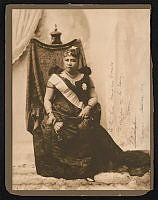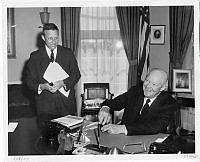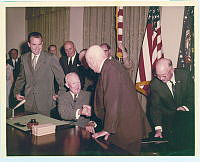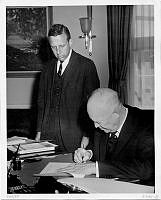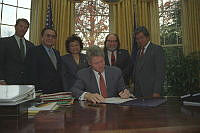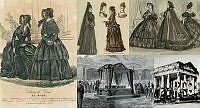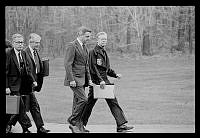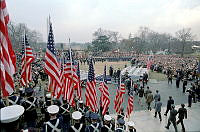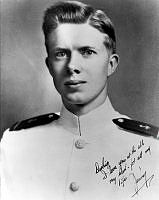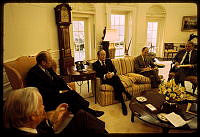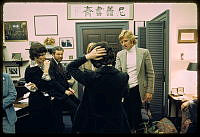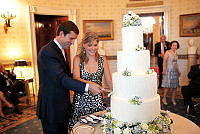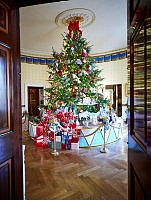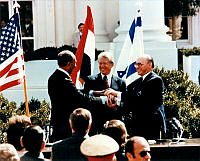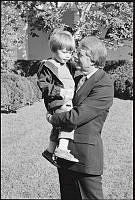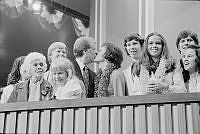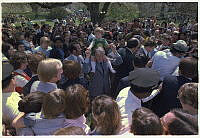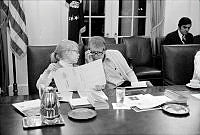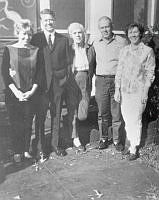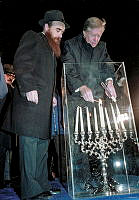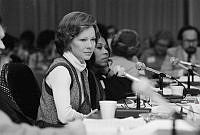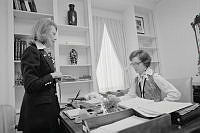"A Journey into Nowhere"
The Redirected Vacation of Harry S. Truman
Copyright © Fall 2010 White House Historical Association. All rights reserved under international copyright conventions. No part of this article may be reproduced or utilized in any form or by any means, electronic or mechanical, including photocopying, recording, or by any information storage and retrieval system, without permission in writing from the publisher. Requests for reprint permissions should be addressed to books@whha.org
By the summer of 1946, President Harry S. Truman needed a vacation. Catapulted into the presidency by the sudden death of Franklin D. Roosevelt in April 1945, the former vice president had presided over the end of World War II that spring and summer and the uneasy peace that followed. During that time, U.S. relations with the Soviet Union deteriorated as the Soviets sought to create a protective zone for themselves by absorbing the countries of Eastern Europe. At the same time, all Europe lay in ruins, its economies devastated, its people starving, and its institutions destroyed. Parts of Asia were equally desolate, particularly the cities of Hiroshima and Nagasaki, obliterated when the United States dropped the first atom bombs in August 1945. Other parts of Asia were in turmoil as British, French, and Dutch colonies agitated for independence. Meanwhile, in China the civil war between the Communist forces of Mao Zedong and the Nationalist troops of Chiang Kai-shek (Jiang Jie-shi) raged as Mao’s guerrillas advanced steadily against Chiang’s larger, better equipped army — a situation Truman described as “very, very bad.” Hovering over all these problems was the threat of nuclear war that seemed to many observers an increasingly likely possibility, especially after newspapers reported Soviet agents in Canada had been caught smuggling atomic secrets to the Soviet Union.1
At home, the United States had swiftly reverted to a peacetime economy while absorbing 10 million returning military personnel. Still, a series of strikes in the steel, coal, and railroad industries had angered the public, as did the 25 percent hike in prices that followed upon Truman’s ending price controls in June. Shortages of meat and housing further aggravated consumers, who blamed the president for their economic woes. Truman’s weak leadership — he was still adjusting to the demands of the presidency — aggravated these problems and fed Republicans’ hopes for winning Congress in the November election.2
Personal concerns also troubled Truman that summer. His mother Martha’s health was failing. “She’s on the way out,” Truman told his wife, Bess, then in Independence, Missouri, caring for her own mother. The president’s health, usually robust, was none too good. He suffered an ear infection as well as recurring stomach pains.3

“The Log of the President’s Vacation Cruise” contains this map of President Harry S. Truman’s vacation route from August 16, 1946, to September 2, 1946.
Harry S. Truman Presidential Library and Museum/ NARAEager to put as much distance as possible between himself and his problems, the president initially considered a trip to Alaska. He settled instead for a cruise up the New England coast on the presidential motor yacht, the USS Williamsburg. Truman, a native of landlocked Missouri, loved the yacht though he was not the best of sailors, especially if the seas were choppy. Bill Campbell, a lieutenant on the Williamsburg, recalled that during one difficult voyage from Washington to Key West, Florida, the seasick president told him, “Young man, if you can stop this boat from rolling you can have my job.”4
Seasickness aside, Truman found cruising, particularly on the Potomac River and Chesapeake Bay, a quick, easy escape from the pressures of the presidency. Aboard the Williamsburg, he could work without interruption, entertain friends and members of his staff, or just relax. The yacht offered him “a quiet haven,” recalled one of his naval aides, Commander William M. Rigdon. “He felt free to stroll the deck, work at his desk, sit in the sun, swim, read, . . . do whatever he pleased, without . . . a host of people constantly hovering about him.”5

On August 17, 1946, President Harry S. Truman swam at Cape Henlopen with Captain James Foskett and the ship’s doctor, Commander Emerson.
Harry S. Truman Presidential Library and Museum/ NARAOn this particular New England voyage Truman’s companions included his friend Ted Marks, best man at his 1919 wedding to Bess; Press Secretary Charlie Ross; Clark M. Clifford, Special Counsel to the President; George E. Allen, Director of the Reconstruction Finance Corporation; Major General Harry H. Vaughan, the president’s military aide; Captain James H. Foskett, Truman’s naval aide; Colonel Wallace H. Graham, the president’s personal physician; and six Secret Service agents. Matt Connelly, Truman’s appointments secretary, accompanied the party as far as Quonset Point, Rhode Island, as did Secretary of the Treasury John W. Snyder.6 Four wire service reporters, eleven print journalists, four radio journalists, three still photographers, and one newsreel pool representative followed about 500 yards behind in the USS Weiss. They kept abreast of Truman’s doings via a daily radio telephone briefing from Charlie Ross. Radio teletype installed aboard the Weiss enabled the reporters to file their stories.7
Truman and his companions embarked from the Washington Navy Yard on the afternoon of August 16 in drizzling rain after posing for photographs on the Williamsburg’s quarterdeck. The first two days of the cruise were uneventful. Truman napped, swam, read (The Life of Grover Cleveland and The Age of Jackson), watched movies, and generally relaxed. Ross told reporters the president “would make no public appearances . . . [or] speeches.” Truman would go ashore “several times,” but the reporters could not report any details until he returned to the yacht. The president also asked that naval ceremonial be kept to a minimum except in the case of the USS Missouri. If the Williamsburg encountered that ship, the Missouri had permission to render full honors to the commander in chief including a presidential gun salute.8

On August 18, 1946, USS Weiss, the escort ship for the Williamsburg moored at the Naval Air Station at Quonset Point. The USS Philippine Sea is seen in this photograph taken from the Williamsburg.
Harry S. Truman Presidential Library and Museum/ NARAThe Williamsburg reached the Naval Air Station at Quonset Point around 4:00 p.m. on Sunday, August 18. After greeting the naval dignitaries and meeting with the Secretary of the Navy James V. Forrestal, who was staying at his summer home in Newport, Rhode Island, Truman held a short press conference for the reporters traveling with him. He told them he was on a vacation cruise and politics had no place on his itinerary.9 He and his guests left in a five-car motorcade for a family “supper” prepared by Captain Foskett’s wife and held at the home of her mother. Truman driving his own car—a Mercury Cabriolet with the top down—led the way. After dining on ham and chicken pie—the president “does not like seafood,” Mrs. Foskett told the press—Truman and his party returned to the Williamsburg.10
The next morning Truman met briefly with Edward H. Foley, assistant secretary of the treasury, and then with U.S. Solicitor General J. Howard McGrath, who was running for the Senate from Rhode Island, and Rhode Island Governor (later Senator) John O. Pastore before leaving for the Naval War College in Newport. Despite poor weather—the New York Times described it as “a driving northeaster”—Truman and his party, which in addition to McGrath and Pastore included General Vaughan, Captain Foskett, and appointments secretary Matt Connelly, toured the college and spoke briefly and extemporaneously to 150 officers attending a War College seminar. He also “looked over” the General Line School at the adjacent Naval Training Station, where he greeted a group of reserve officers. After lunch, the party returned to the Williamsburg, where Truman spent the rest of the day.11
We are just moving around, heading in a general southerly direction with no fixed destination. It’s just a vacation and the President can frolic around in the Atlantic if he wants to.
On Tuesday, continued bad weather caused the Williamsburg to change course abruptly. At least that’s what Ross told the traveling press corps. In reality, Truman felt besieged. “Callers, would-be callers, and invitations to come ashore for ceremonies or parties,” to say nothing of the “almost constant gun salutes and other honors,” threatened to turn his vacation into a extension of life in the White House. Truman was having none of it. “Everybody and his brother whom I didn’t want to see tried by every hook or crook to rope me into letting him come aboard or having me seen with him,” he wrote his mother on August 22. “So I just cancelled the trip.”12
Instead of sailing up the Atlantic Coast toward Eastport, Maine—his original destination—Truman told the captain to put out to sea. Reporters aboard the Weiss noticed the change almost immediately and began to speculate on the reasons for the switch. Since the weather report called for “clearing weather with sunshine” in New England, the traveling press corps speculated that Truman perhaps did not want to be too far from Washington in case a diplomatic crisis developed. They also considered the Truman’s tendency to seasickness a factor, although a heavy ground swell in the Atlantic that already caused the Williamsburg to pitch in “an uncomfortable manner” made that conjecture unlikely. Press secretary Ross refused to enlighten the reporters, saying that the Williamsburg was “on a journey into nowhere. We are just moving around, heading in a general southerly direction with no fixed destination. It’s just a vacation and the President can frolic around in the Atlantic if he wants to.”13

On August 22, the president’s party arrived in Bermuda and were greeted by Admiral Sir Ralph Leatham, the governor of Bermuda, seen here in his ceremonial landau beside President Harry S. Truman.
Harry S. Truman Presidential Library and Museum/ NARAMore probably, the delay occurred because the State Department and, possibly, the Secret Service and the U.S. Navy were making arrangements for a presidential trip to Bermuda that would be short on ceremony and long on relaxation.14 Five hours later, the diplomatic arrangements completed, Ross told the bewildered reporters that Truman and his party were heading for the island. “The boss decided last night to go into warm waters,” he said by way of explanation. He failed to say how long Truman would stay on the island or where he would go from there.15
In keeping with Truman’s desire for no “fuss or feathers,” the Williamsburg arrived without fanfare at the American naval base in Bermuda at 9:30 a.m. on Thursday, August 22. “This is what we’ve been looking for,” Ross told reporters, “and it’s here we’ll stay till further notice anyway.” He went on to quash reporters’ questions about possible high-level meetings on the island, saying that Truman’s visit was “absolutely without any political significance.” Admiral Sir Ralph Leatham, governor of Bermuda, underlined that point when he spoke to reporters after his formal 15-minute call on Truman. “He [Truman] has told me that he has come to Bermuda because he wants rest and quiet. He [told me] that he would appreciate anything that I could to do to assure that his wishes are respected.” Truman’s activities reinforced that message. After Leatham left the ship, the president and his guests went for a swim. Later in the afternoon Truman and his military and naval aides returned the governor’s call, riding to Government House in the governor’s ceremonial horse-drawn carriage. In Truman’s honor, Bermuda had declared a half holiday. U.S. and British flags decorated the buildings and streets of Hamilton, the capital, but except for a crowd of several hundred at Albouys Point, where Truman debarked, the streets were empty in deference to the president’s desire for privacy. After tea with the governor, Truman and his aides returned to the Williamsburg.16
The next day Truman’s vacation began in earnest with a fishing trip 5 miles off the southern tip of Bermuda. Despite his aversion to fishing (he considered it “a waste of time”) the New York Times reported that the president caught three fish, including the largest one of the day—a 6H pound salmon rockfish. Truman’s account of the expedition was more vivid. “Ted [Marks] caught a big brown fish and Captain Foskett caught four not so large as mine,” he wrote his daughter, Margaret. “The rest caught none.” He further reported, “Clifford almost fell overboard, Vaughan got seasick and Allen told me how good he is with fish but they didn’t take to him.”17
A rain squall cut short the fishing expedition and sent the Truman party back to the Williamsburg, where the president spoke with Secretary of State James F. Byrnes via radio phone from Paris, where Byrnes and other Allied representatives were negotiating peace treaties formally ending World War II with Italy, Romania, Hungary, Bulgaria, and Finland. Thereafter the ship’s log reports that the president and his party “whiled the evening away in their quarters”—perhaps an oblique reference to a poker game, one of Truman’s favorite forms of relaxation.18

President Harry S. Truman, seen after hooking the largest catch of the day, enjoyed a week of fishing, swimming, and poker playing in Bermuda before beginning the voyage back to Washington on August 30, 1946.
Harry S. Truman Presidential Library and Museum/ NARAOn Saturday Truman toured Bermuda by car, stopping at the local Masonic Lodge, where he signed a Bible once signed by George Washington, and visiting other points of interest. The next day, Sunday, he walked to Holy Trinity Cathedral, where he attended services with the governor of Bermuda and heard the bishop of Bermuda pray for the success of the United Nations and for a way to be found to send homeless European Jews to Palestine. After the church service, Truman walked back to the Williamsburg accompanied by a small crowd who followed him back to his launch.19
The next week passed in a leisurely fashion. Truman and his party fished, swam, watched movies, and rested—and probably played more poker.20 After being rained out on a second fishing expedition, Truman and his guests tried again on Thursday, August 29.
The group set out in two boats for a spot about 5 miles off the southern tip of Bermuda. Felix Belair Jr. of the New York Times captured the spirit of the outing. Truman, he said, had “agreed to defend his title of champion fisherman of the . . . Williamsburg in a catch-as-catch-can contest” against his friend Ted Marks, an experienced fisherman. Secretary of the Treasury John Snyder, who had flown in from Washington several days earlier, was also involved in the matchup, but “although the smoothest operators in naval intelligence were assigned the job none was able to learn on which side he would be fighting.” Since friendly wagers had been made on the combined catch of each boat, competition was keen. At the last minute Snyder threw in his lot with the president, as did his naval aide Captain Foskett and press secretary Ross. Together the Truman team was credited with forty fish weighing 75H pounds. The Marks team, which in addition to Ted Marks consisted of ace fishermen Allen and Vaughan plus novice Clark Clifford, using a special doughnut bait, came up short, with twenty fish weighing 61G pounds.21
According to the ship’s log, the losers attempted to “increase the weight of their catch by filling a fish with lead sinkers” (weights). However, when they were convinced they had lost, the log went on, “they gallantly acknowledged their perfidy.” Although Truman retained his title, he remarked that he “would never make a great fisherman. I haven’t got the infinite patience required.”22
Truman returned to the Williamsburg where he held a small reception for the governor of Bermuda. Members of the colony’s Parliament and other distinguished officials also attended, along with local citizens, the U.S. consul general in Bermuda, and senior members of the U.S. forces stationed there. According to the log, “the president and his party spent the evening on board in the guests’ quarters” — perhaps playing poker.23

President Harry S. Truman stood on deck during the return trip up the Potomac River to Washington, D.C., on September 2, 1946.
Harry S. Truman Presidential Library and Museum/ NARAThe next day Truman left Bermuda. As he did, he received a farewell message from the island’s governor Sir Ralph Leatham. In his message, Leatham told Truman, “We have deemed it a great honor that you chose Bermuda for your holiday. . . . We shall always remember that you were the first President in office to visit our Colony and hope that you honor us again.” Truman thanked Leatham for his “kind message. Everyone enjoyed our visit to Bermuda and hope to come back. Please express my appreciation to the inhabitants of Bermuda for all their courtesy.” Truman also thanked the U.S. naval personnel stationed in Bermuda for their efforts. “To all hands a well earned ‘Well Done.’”24
Truman’s return voyage to Washington was largely uneventful. Bad weather and rough seas early in the voyage caused many aboard the Williamsburg to keep to their quarters and assume “a horizontal position.” Truman, writing to his mother and his sister Mary, provided a graphic account of his own distress. “I became seasick at the dinner table and rushed to my quarters and to bed. Stayed there most of yesterday. Ate no breakfast or lunch did manage a cup of tea and two sandwiches about eight o’clock last night. Saturday morning it was so rough that furniture, ink bottles, magazines, clothing and pillows got completely mixed up on my floor.”25
By the time the ship reached Hampton Roads, Virginia, on Sunday, September 1, however, the sun shone and so many pleasure craft had crowded around the Williamsburg that a picket boat from the Weiss had to guard the presidential yacht as it lay at anchor.26 Return to U.S. waters also meant the resumption of official business. Postmaster General Robert Hannegan, Reconversion Director John R. Steelman, and Presidential Secretary Bill Hassett came aboard the ship, as did a naval ensign who brought the White House mail.27 Despite the press of public business, a holiday mood prevailed once the Williamsburg headed into the Potomac River. Some of Truman’s guests attired in bathing suits engaged in a spirited game of volleyball using the ship’s last remaining medicine ball. (The other ball had been lost at sea during an earlier contest.) When the last ball also went over, the two sides pinchhit with rope rings or grommets used to secure equipment on board and continued to play. The ship’s log noted tactfully that the grommets “had been made up in quantity and were easily replaceable.”28
The atmosphere turned solemn, however, as the yacht passed Mount Vernon. The presidential party and the ship’s crew assembled on deck and paid traditional honors to George Washington.29 At that point, the Williamsburg and the Weiss were close enough to Washington that the captain of the Weiss asked permission to go ahead so that the reporters aboard could be at the pier when Truman and his party arrived. The press pool greeted the president as he debarked looking tan and rested. Truman’s sudden alteration to Bermuda had been a great success, and he had returned refreshed and ready to face the challenges of the presidency. There would be other seagoing voyages aboard the Williamsburg30 and other presidential vacations, but never again in his presidency would Truman change his travel plans so abruptly or chart a course for “a journey into nowhere.”

After disembarking at the Washington Navy Yard on September 2, 1946, President Truman spoke briefly with reporters before returning to the White House by car.
Harry S. Truman Library and Museum












